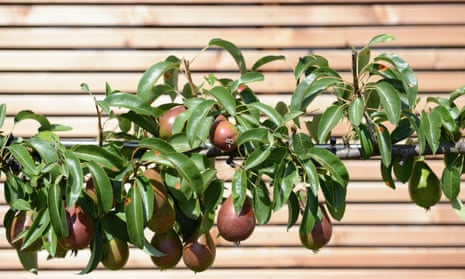Amorning poking around one of my favourite gardens reminded me that my stepover apples need a prune. They are dancing wildly around their wires, going hell for leather to become the tree they secretly want to be. Poor stepovers.
The Guardian’s product and service reviews are independent and are in no way influenced by any advertiser or commercial initiative. We will earn a commission from the retailer if you buy something through an affiliate link. Learn more.
Summer pruning is an essential if oft forgotten task for more than just stepovers, espaliers and other restricted fruit trees. Plums, cherries, apricots, almonds and other prunus species are also pruned between July and August to reduce silverleaf, a fungal disease caused by Chondrostereum purpureum. The leaves become covered in a slivery sheen and eventually the branch will die. A bracket-shaped fungus (white and woolly above and purple-brown with spores) often appears on older, dead branches. The most infectious spores are produced in winter under damp conditions, so the idea is to prune now when there are fewer spores and the pruning wound can heal quickly. You can remove dead, diseased or badly placed branches as well as crown lifting (removing the lower branches) for better access under the tree.
In general, I think a little summer pruning is worthwhile for any tree. Only in leaf do you get to see its true shape, and removing the odd branch to better frame a view or allow your eye to be drawn further down the garden can have a dramatic effect. Crown thin to let more light through as well, but never take more than 30% of the overall foliage.
But back to those stepover apples. Prune restricted forms too early in summer and you can encourage a second flush of vegetative growth, particularly if it’s a wet year. This growth doesn’t have time to harden up properly, so it’s more susceptible to frost damage and canker. By waiting until mid-August to early September, you will encourage fruit bud production, which is what you are after.
Prune new growth back to an inch or so (or a couple of buds, whatever makes most sense), always choosing an outward-facing bud. This will encourage short spurs that will produce next year’s fruit buds. It will also let in considerably more sunlight on to existing fruit, allowing them to ripen better.
Unrestricted fruit trees not in the stone fruit category (apples, pears and the like, which actually look like a tree) aren’t pruned in this way. The main time for pruning these is winter, when structural and architectural work can take place. If you feel the need to do some light summer pruning, do it before the longest day (so it’s one to mark on the calendar for next year).
Finally, magnolias and walnuts are finicky if pruned, and it has been noted that they heal much quicker if any pruning work takes place from mid-August to September, so if there’s a branch that’s been bothering you for some time, now is your moment to chop, chop.

Comments (…)
Sign in or create your Guardian account to join the discussion